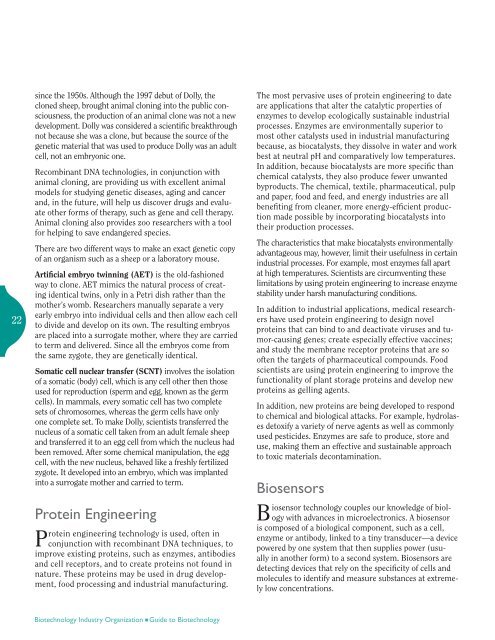Introduction Guide to Biotechnology - Biomolecular Engineering Lab
Introduction Guide to Biotechnology - Biomolecular Engineering Lab
Introduction Guide to Biotechnology - Biomolecular Engineering Lab
Create successful ePaper yourself
Turn your PDF publications into a flip-book with our unique Google optimized e-Paper software.
22<br />
since the 1950s. Although the 1997 debut of Dolly, the<br />
cloned sheep, brought animal cloning in<strong>to</strong> the public consciousness,<br />
the production of an animal clone was not a new<br />
development. Dolly was considered a scientific breakthrough<br />
not because she was a clone, but because the source of the<br />
genetic material that was used <strong>to</strong> produce Dolly was an adult<br />
cell, not an embryonic one.<br />
Recombinant DNA technologies, in conjunction with<br />
animal cloning, are providing us with excellent animal<br />
models for studying genetic diseases, aging and cancer<br />
and, in the future, will help us discover drugs and evaluate<br />
other forms of therapy, such as gene and cell therapy.<br />
Animal cloning also provides zoo researchers with a <strong>to</strong>ol<br />
for helping <strong>to</strong> save endangered species.<br />
There are two different ways <strong>to</strong> make an exact genetic copy<br />
of an organism such as a sheep or a labora<strong>to</strong>ry mouse.<br />
Artificial embryo twinning (AET) is the old-fashioned<br />
way <strong>to</strong> clone. AET mimics the natural process of creating<br />
identical twins, only in a Petri dish rather than the<br />
mother’s womb. Researchers manually separate a very<br />
early embryo in<strong>to</strong> individual cells and then allow each cell<br />
<strong>to</strong> divide and develop on its own. The resulting embryos<br />
are placed in<strong>to</strong> a surrogate mother, where they are carried<br />
<strong>to</strong> term and delivered. Since all the embryos come from<br />
the same zygote, they are genetically identical.<br />
Somatic cell nuclear transfer (SCNT) involves the isolation<br />
of a somatic (body) cell, which is any cell other then those<br />
used for reproduction (sperm and egg, known as the germ<br />
cells). In mammals, every somatic cell has two complete<br />
sets of chromosomes, whereas the germ cells have only<br />
one complete set. To make Dolly, scientists transferred the<br />
nucleus of a somatic cell taken from an adult female sheep<br />
and transferred it <strong>to</strong> an egg cell from which the nucleus had<br />
been removed. After some chemical manipulation, the egg<br />
cell, with the new nucleus, behaved like a freshly fertilized<br />
zygote. It developed in<strong>to</strong> an embryo, which was implanted<br />
in<strong>to</strong> a surrogate mother and carried <strong>to</strong> term.<br />
Protein <strong>Engineering</strong><br />
Protein engineering technology is used, often in<br />
conjunction with recombinant DNA techniques, <strong>to</strong><br />
improve existing proteins, such as enzymes, antibodies<br />
and cell recep<strong>to</strong>rs, and <strong>to</strong> create proteins not found in<br />
nature. These proteins may be used in drug development,<br />
food processing and industrial manufacturing.<br />
The most pervasive uses of protein engineering <strong>to</strong> date<br />
are applications that alter the catalytic properties of<br />
enzymes <strong>to</strong> develop ecologically sustainable industrial<br />
processes. Enzymes are environmentally superior <strong>to</strong><br />
most other catalysts used in industrial manufacturing<br />
because, as biocatalysts, they dissolve in water and work<br />
best at neutral pH and comparatively low temperatures.<br />
In addition, because biocatalysts are more specific than<br />
chemical catalysts, they also produce fewer unwanted<br />
byproducts. The chemical, textile, pharmaceutical, pulp<br />
and paper, food and feed, and energy industries are all<br />
benefiting from cleaner, more energy-efficient production<br />
made possible by incorporating biocatalysts in<strong>to</strong><br />
their production processes.<br />
The characteristics that make biocatalysts environmentally<br />
advantageous may, however, limit their usefulness in certain<br />
industrial processes. For example, most enzymes fall apart<br />
at high temperatures. Scientists are circumventing these<br />
limitations by using protein engineering <strong>to</strong> increase enzyme<br />
stability under harsh manufacturing conditions.<br />
In addition <strong>to</strong> industrial applications, medical researchers<br />
have used protein engineering <strong>to</strong> design novel<br />
proteins that can bind <strong>to</strong> and deactivate viruses and tumor-causing<br />
genes; create especially effective vaccines;<br />
and study the membrane recep<strong>to</strong>r proteins that are so<br />
often the targets of pharmaceutical compounds. Food<br />
scientists are using protein engineering <strong>to</strong> improve the<br />
functionality of plant s<strong>to</strong>rage proteins and develop new<br />
proteins as gelling agents.<br />
In addition, new proteins are being developed <strong>to</strong> respond<br />
<strong>to</strong> chemical and biological attacks. For example, hydrolases<br />
de<strong>to</strong>xify a variety of nerve agents as well as commonly<br />
used pesticides. Enzymes are safe <strong>to</strong> produce, s<strong>to</strong>re and<br />
use, making them an effective and sustainable approach<br />
<strong>to</strong> <strong>to</strong>xic materials decontamination.<br />
Biosensors<br />
B<br />
iosensor technology couples our knowledge of biology<br />
with advances in microelectronics. A biosensor<br />
is composed of a biological component, such as a cell,<br />
enzyme or antibody, linked <strong>to</strong> a tiny transducer—a device<br />
powered by one system that then supplies power (usually<br />
in another form) <strong>to</strong> a second system. Biosensors are<br />
detecting devices that rely on the specificity of cells and<br />
molecules <strong>to</strong> identify and measure substances at extremely<br />
low concentrations.<br />
<strong>Biotechnology</strong> Industry Organization n <strong>Guide</strong> <strong>to</strong> <strong>Biotechnology</strong>
















